Features of sparaxis and its cultivation
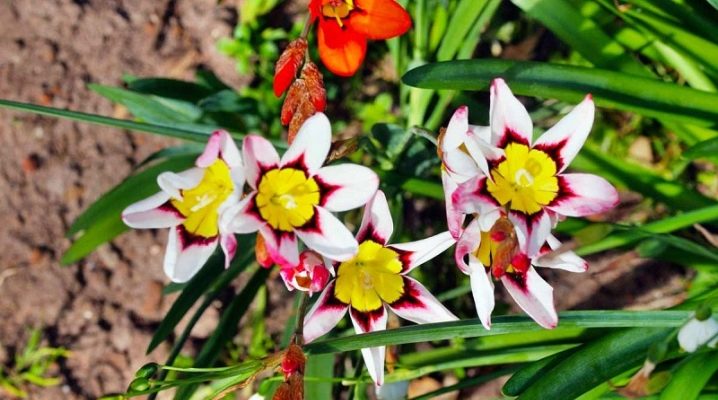
The features of sparaxis and its cultivation depend on many circumstances - the climatic conditions of the region, compliance with the prescribed agricultural technology, the chosen place for breeding, the quality of the planting material. Breeding an ornamental garden and greenhouse plant is a bit troublesome, but rewarding. The flower responds to every action with a luxurious and long flowering.
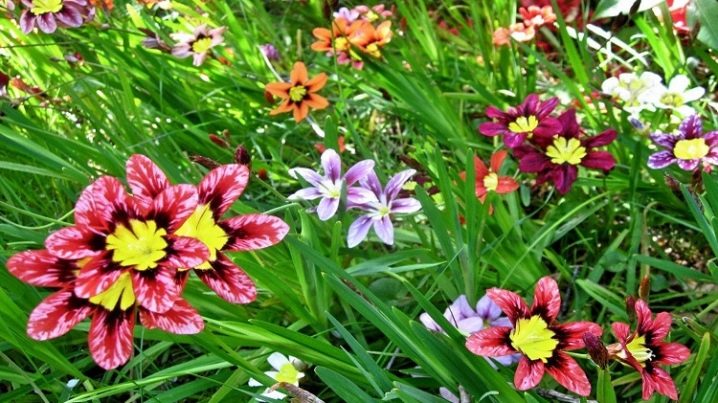
general description
There is nothing romantic about the name of sparaxis. Translated from Greek, this is "split ends of the bracts." Iris, to which the plant belongs, is an extensive family from the order of the asparagus. They are distinguished by the specificity of rhizomes, prudently arranged by nature to continue life, with a pre-prepared supply of nutrients. These are corm perennials, which are herbaceous varieties.
The number of sparaxis species available to the grower is simply amazing. If you use the numerous masterpieces created by nature and bred by breeders, you do not need to turn to other ornamental crops. Species of this genus, brought from the Cape region, located in South Africa, allow you to create aesthetic visualization using only this plant.
A well-known database mentions 15 types of flowers, but in the domestic floriculture, its decorative potential has not yet received a worthy assessment, possibly due to such an exotic multicolor.
Its unusual leaves and large corollas come in a wide range of colors, and the plants raise concerns about the complexity of growing techniques.
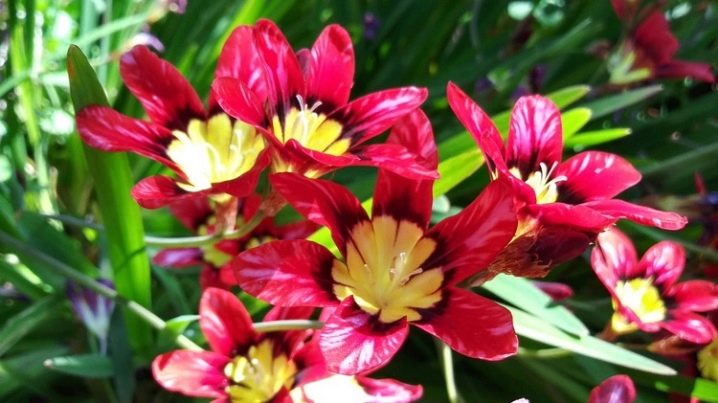
However, sparaxis is no more difficult to care for than gladioli or tritonia (another well-known iris plant). Let's consider some of its features:
- the leaves of the plant grow up to a meter in height, they are of a beautiful emerald color and whimsical shape;
- group flowering is achieved if the bulbs are planted close to each other in the garden, but single ones also look very impressive;
- throwing out a powerful, more than half a meter, peduncle, the plant opens a large corolla or dissolves a spike-shaped inflorescence with several star-shaped flowers;
- distinguish between tall and compact varieties, differentiate by the number of flowers on the peduncle, the number of tones in a whimsical design;
- different flowering times, determined by the specifics of the climate, are not a method to distinguish between the available varieties, this is just a consequence of the care taken or ignored.
Experts in this area note that in the south, sparaxis begins to bloom at the end of spring and pleases the owner of the plot or front garden throughout the warm season. This is due to the fact that the conditions are close to natural in which it was found.
For those who intend to cultivate it in a temperate climate, the care procedure is a little more complicated, and the decorative component will appear only before autumn, but will please the eye no less.
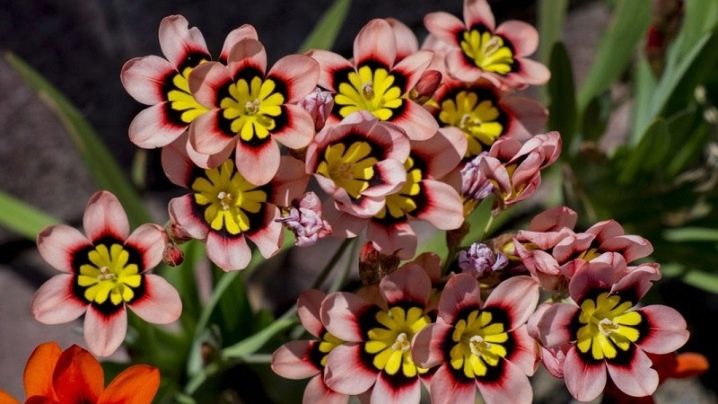
Types and popular varieties
The flower, which is gaining more and more popularity in the local area, in the small front gardens of apartment buildings and summer cottages of lovers of not practical, but excellent use of land, is distinguished by a rainbow variety of colors even in the most common varieties.You can choose from varieties with a different number of corollas, from 3 to 9 per peduncle. The assortment of bright colors is unlimited and will satisfy even the most whimsical imagination.
- Known in wide circles, the tricolor hybrid is relatively low (about 40 cm). It forms up to 7 flowers on peduncles, it is distinguished by tricolor petals with a light corolla and a dark ring that delimits a spectacular core. A colorful mix is formed from contrasting tones. The flowers bloom alternately for a long lasting effect. There are tricolor sparaxis in different combinations, it is difficult to choose the most spectacular, especially since the impression is enhanced by the xiphoid leaves, which play the role of an excellent background for inflorescences.
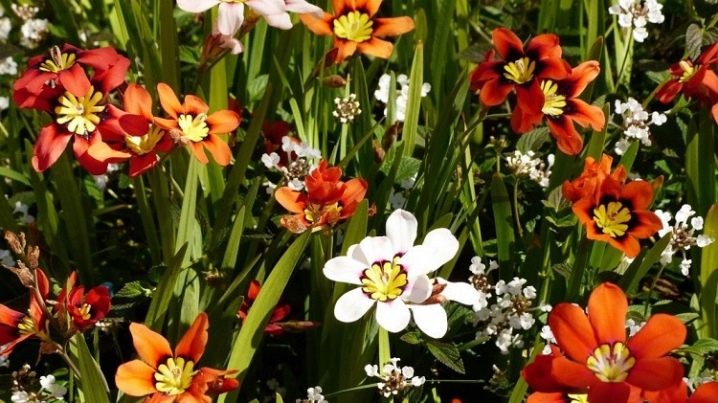
- Another mix is sparaxis graceful, in which the combination of orange, burgundy and purple is recognized as the most popular. This is a low-growing variety, 15-25 cm in height, but this makes it no less beautiful and exotic. During the flowering period, this is a bright spot of color in any kind of flower bed or framed by a garden path. Sparaxis can be found in specialized stores under the name mix, which means that it will grow no more than 25 cm in height, but it will come in different colors.

- Bilbeefer in contrast to the tricolor is limited in the color palette, but its aesthetics and tenderness, the prevalence of white, cream and golden scales, the optimal height (50-60 cm) are invariably in demand among amateurs. It is difficult for them to choose between three color options - white, and cream, and golden tones are good.

- Sparaxis grandiflora It is not often found in retail sale, but for those who have already planted this perennial, it is difficult to refuse a tall plant with a pleasant and unique aroma. Grandiflora got its second name - fragrant - thanks to this feature. For decorative purposes, you can use three different colors - white, purple-purple and yellow. Perhaps it will be possible to find new items from breeders.
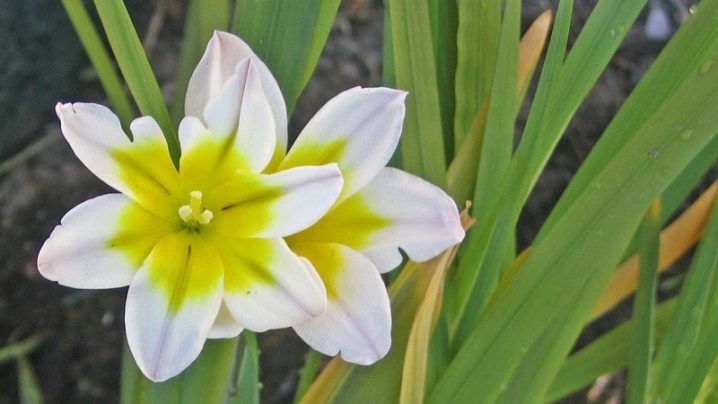
- Superba is a relatively short variety, up to 30 cm, forms several flowers on a peduncle, on sale you can find a multi-colored mix or monochrome - yellow, orange, lilac, lilac, white, with a dark stripe and a yellow center.
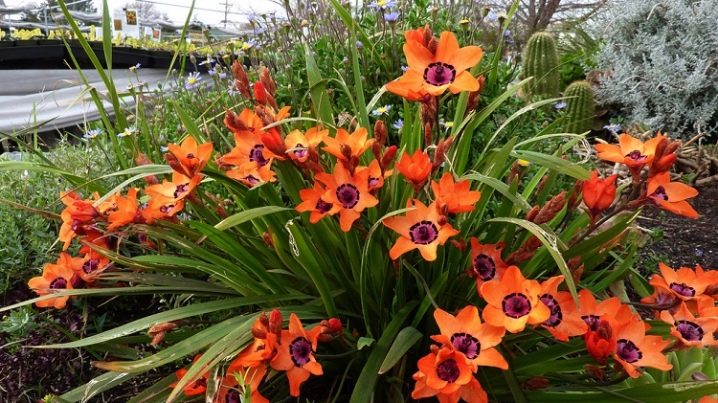
- The eloquently named variety "Sunny Day" it is distinguished by a pleasant golden yellow tone, which creates a good mood even in cloudy weather. The dark core and subtle brownish stripes on the rim only emphasize the overall impression.
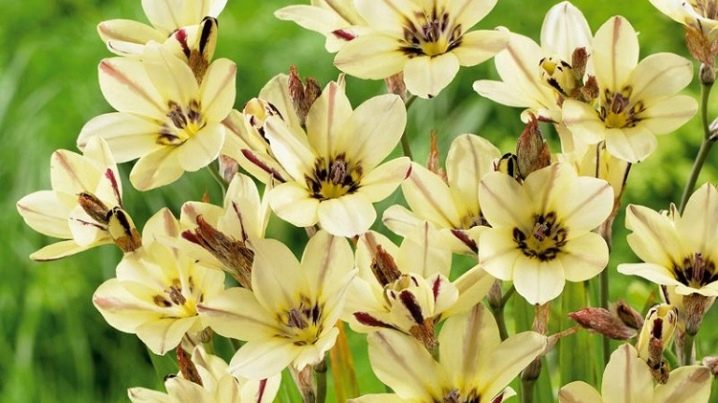
- Alba Maxima, also known as Mont Blanc, - dazzling white with a bright yellow center. It has a repeating rim pattern and is traditionally elegant and effective in any application.
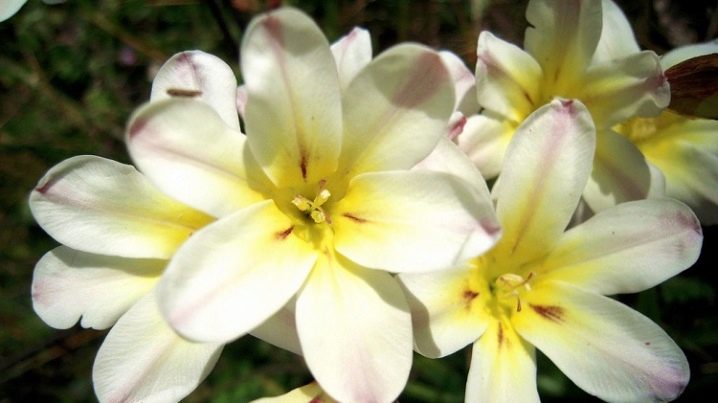
- No less picturesque are "The Fiery King" and "The Lord of Fire" - raspberry and red varieties with an intense yellow center. The shade of the petals is not uniform, but rather marbled. The dark frame separating the middle from the main tone enhances the impression made on the viewer.
Geophyte, the main organ of which is a corm, grows in the wild during the rainy season. At this time, its aboveground part is atrophied, giving the main organ a rest.
In a temperate climate, it is impossible to create a natural habitat characteristic of the Southern Hemisphere and the tip of the African continent. But it can be imitated using the recommended agricultural techniques.
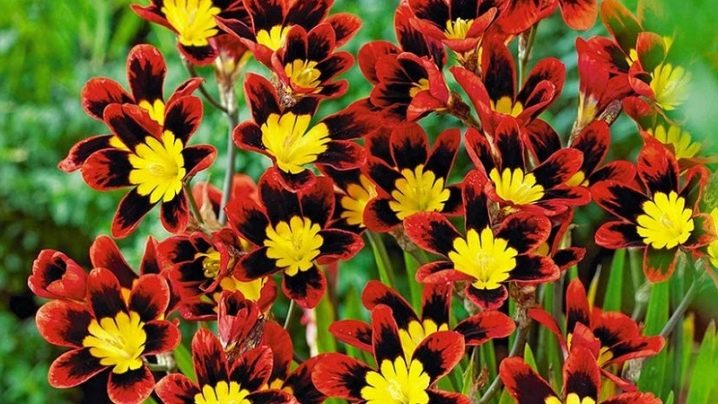
Landing
It is recommended to plant a beautiful exotic plant in a well-lit space, in sandy soil, with small additions of clay and peat. An attempt to grow it in close proximity to trees and shrubs, in permanent shade, is doomed to failure. The culture is undoubtedly convenient for the grower, who has a lot of work in the spring, and everything falls on the days with warm air. This includes early planting, it is carried out in the third decade of April (earlier in the south).Sparaxis requires a temperature of no higher than 15 degrees so that it can intensively develop flower buds.
There are no dramatic differences in planting methods, whether you choose Elegance, Jumbo, Star Mix, or striped sparaxis for this purpose. The plant must be planted in a timely manner, the tubers can be purchased in a nursery or a specialized store and placed at a depth of 5 cm, observing a distance of 5 to 10 cm, depending on the imagination and goals of the home landscape designer.
Growing care
Outdoor placement can be carried out using the knowledge and skills already acquired in caring for bulbous plants. If this happens in the garden, you need to keep the distance from shrubs and trees, preferably in an open flower bed, along paths or under a fence, where shade is only for a short time.
The tubers are not adapted to survive in temperate climates with pronounced seasons and frosty winters. Therefore, they are recommended to be dug up, stored in a cool and dry room.
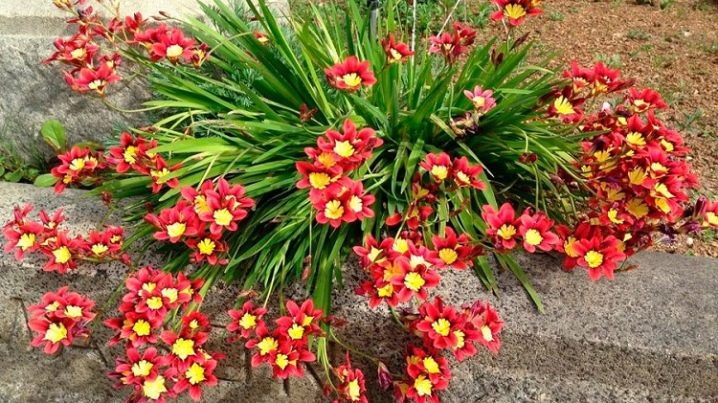
Conditions
In addition to watering and feeding, they highlight some recommendations, nuances, observing which you can achieve greater success.
- Spring should be cool, with a lot of precipitation, otherwise the leaves will begin to dry and the number of peduncles will decrease. This can be avoided if you do not forget about watering, which continues until flowering.
- Mulching with pine bark or other similar materials will prevent weeds from growing and drying out the soil.
- If you plant the tubers gradually and orderly, you can stretch the flowering. This should be done from April to the end of May, because flowering begins two months after planting and lasts a little more than 20 days.
Timely planting, watering and feeding, good lighting, sandy, light soil (a special substrate, or flavored with clay and peat), care during the flowering period are the main conditions that must be adhered to.
Watering and feeding
Moderate watering is necessary during the period of development and growth, if the spring does not please with precipitation. Excess moisture can lead to rot and death of plants. In the dry season, watering is carried out at least 2 times a week, even in the morning and in the evening. At high temperatures during the day, it is optimal to carry out morning sprinkling. Fertilizers will be required phosphorus, nitrogen and potash - respectively, in the spring and at the beginning of budding. Wood ash, which is added a couple of times to the beds with sparaxis, will not interfere.
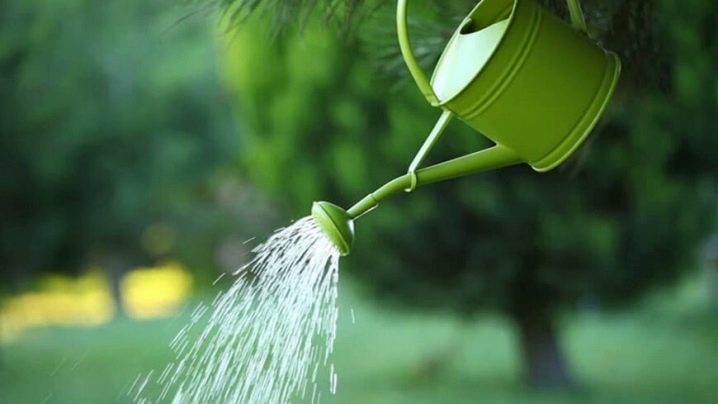
Wintering
In the south, the beds are simply mulched for the winter with spruce branches, but in the middle lane, after top dressing, they are stopped to water, and then they are dug out, soaked in a solution of potassium permanganate and dried thoroughly. The digging is carried out with greens, which are cut off only after they have completely dried. The recommended storage temperature is not higher than +7 degrees, in a dark and dry room. Sometimes it is advised to take a box made of natural material for this purpose, and place the tubers in sawdust.
Reproduction methods
The grower, as always in such cases, has several methods at his disposal. The simplest and least expensive in terms of time and energy is planting bulbs. They are collected by themselves or bought. Seed propagation is a bad idea when it comes to hybrids, but purchased ones do not bloom until 3 years after the bulb has developed and matured.
After flowering is complete, you can dig up the mother bulbs and separate the babies from them. Spring planting is carried out only by children, separated immediately before the process and treated in the place of separation with crushed charcoal.
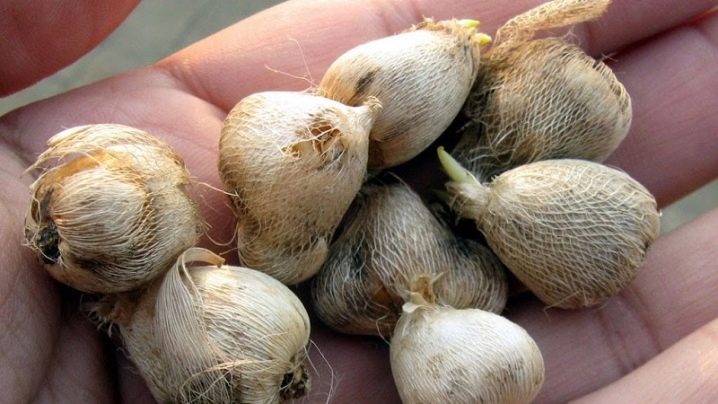
Diseases and pests
Resistance is high, like any hybrid. Root decay and chlorosis, in which it is necessary to carry out the treatment with iron chelate, are all the troubles that await the grower if agricultural technology is not followed.
Application in landscape design
- Group planting is the most common method of using an ornamental plant. Most often, with its help and the use of grassy species, they imitate flower meadows in large areas near country mansions. However, for such beauty, this is too primitive and utilitarian direction. Rockeries, mixborders, terraced and round shapes, pots, flowerpots and tubs on open verandas and patios are just a small list of possibilities.
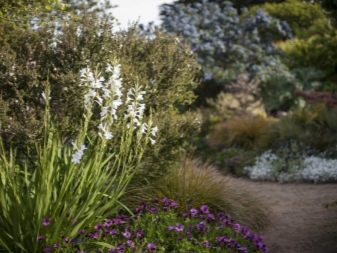
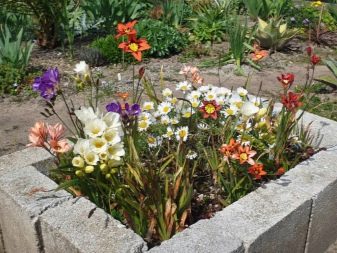
- Citizens can grow perennials in an apartment, on a balcony or a glassed-in loggia, in their front gardens. Breeding all year round in a greenhouse will provide the opportunity for commercial profit. The culture looks great in bouquets, combined with ground cover plants.
It is no exaggeration to call it picturesque and aesthetic, universal in any application.
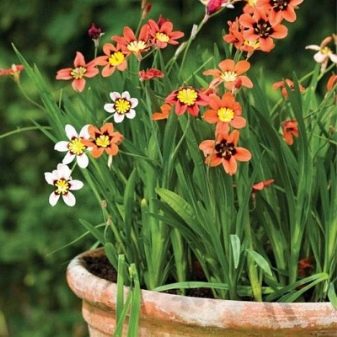
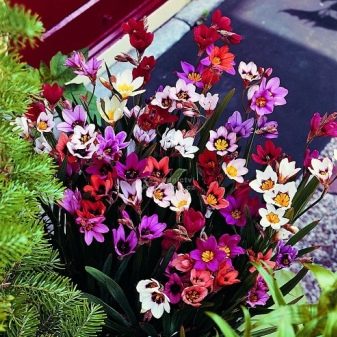







































































































The comment was sent successfully.